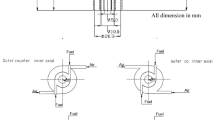Abstract
An experimental study was performed to investigate the macroscopic behavior and atomization characteristics of a high-speed diesel spray impinged on the wall at various injection and impinging conditions. The development processes of sprays impinged on the wall were visualized using the spray visualization system composed of a Nd:YAG laser and an intensified charge-coupled device (ICCD) camera. The atomization characteristics of the impinged spray on the wall were also explored in terms of mean droplet diameter and velocity distributions by using a phase Doppler particle analyzer (PDPA) system. The results provide the effects of injection parameters, wall conditions, and the other various experimental conditions on the macroscopic behavior and atomization characteristics of the impinged sprays on the wall.
































Similar content being viewed by others
References
Amagai K, Arai M, Saito M, Maruyama Y (2003) Spray-to-spray interaction after wall impingement, part 1: fuel adhering behavior on a flat wall. In: Proceedings of the 8th annual conference of liquid atomization and spray systems (ILASS-Asia 2003), Tokyo, Japan, December 2003, pp 145–150
Arcoumanis C, Cutter PA (1995) Flow and heat transfer characteristics of impinging diesel sprays under cross-flow conditions. SAE paper 950448
Assanis DN, Filipi ZS, Fiveland SB, Syrimis M (2000) A methodology for cycle-by-cycle transient heat release analysis in a turbocharged direct injection diesel engine. SAE paper 2000-01-1185
Bai C, Gosman AD (1995) Development of methodology for spray impingement simulation. SAE paper 950283
Bosch W (1966) The fuel rate indicator: a new measuring instrument for display of the characteristics of individual injection. SAE paper 660749
Ebara T, Amagai K, Arai M (1998) Penetration model of a diesel spray along the wall. In: Proceedings of the 4th international symposium on diagnostics and modeling of combustion in internal combustion engines (COMODIA’98), Kyoto, Japan, July 1998, pp 623–628
Guerrassi N, Champoussin JC (1996) Experimental study and modeling of diesel spray/wall impingement. SAE paper 960864
Ikegami M, Nakatani K, Tanaka S, Yamane K (1997) Fuel injection rate shaping and its effect on exhaust emissions in a direct-injection diesel engine using a spool acceleration type injection system. SAE paper 970347
Katsura N, Saito M, Senda J, Saito M, Fujimoto H (1989) Characteristics of a diesel spray impinging on a flat wall. SAE paper 890264
Ko K, Arai M (2002a) Diesel spray impinging on a flat wall, part 1: characteristics of adhered fuel film in an impingement diesel spray. Atomization Spray 12:737–751
Ko K, Arai M (2002b) Diesel spray impinging on a flat wall, part 2: volume and average air-fuel ratio of an impingement diesel spray. Atomization Spray 12:753–768
Lee SH, Ryou HS (2000) Comparison of spray/wall impingement models with experimental data. J Propul Power 16:939–945
Lee C, Lee K, Senda J, Fujimoto H (2001) A study on the spray-wall interaction model considering degree of superheat in the wall surface. Numer Heat Trans B 40:495–513
Meingast U, Staudt M, Reichelt L, Renz U, Sommerhoff FA (2000) Analysis of spray/wall interaction under diesel engine conditions. SAE paper 2000-01-0272
Montajir RM, Tsunemoto H, Ishitani H, Minami, T (2000) Fuel spray behavior in a small DI diesel engine: effect of combustion chamber geometry. SAE paper 2000-01-0946
Naber JD, Reitz RD (1988) Modeling spray/wall impingement. SAE paper 880107
Nehmer DA, Reitz RD (1994) Measurement of the effect of injection rate and split injections on diesel engine soot and NOx emissions. SAE paper 940668
Park K (1994) Development of a non-orthogonal-grid computer code for the optimization of direct-injection diesel engine combustion chamber shapes. PhD dissertation, University of Manchester Institute of Science and Technology (UMIST), England, UK
Schünemann E, Fedrow S, Leipertz A (1998) Droplet size and velocity measurement for the characterization of a DI-diesel spray impinging on a flat wall. SAE paper 982545
Stanton DW, Rutland CJ (1996) Modeling fuel film formation and wall interaction in diesel engines. SAE paper 960628
Wakabayashi C, Saito M, Amagai K, Arai M (2003) Spray-to-spray interaction after wall impingement, part 2: impingement process on various uneven walls. In: Proceedings of 8th annual conference of liquid atomization and spray systems (ILASS-Asia 2003), Tokyo, Japan, December 2003, pp 151–156
Watkins AP, Wang DM (1990) A new model for diesel spray impaction on walls and comparison with experiment. In: Proceedings of the 2nd international symposium on diagnostics and modeling of combustion in internal combustion engines (COMODIA’90), Kyoto, Japan, September 1990, pp 243–248
Acknowledgement
This work was supported by the Korea Research Foundation, grant no. KRF-2003-042-D20025.
Author information
Authors and Affiliations
Corresponding author
Rights and permissions
About this article
Cite this article
Park, S.W., Lee, C.S. Macroscopic and microscopic characteristics of a fuel spray impinged on the wall. Exp Fluids 37, 745–762 (2004). https://doi.org/10.1007/s00348-004-0866-3
Received:
Accepted:
Published:
Issue Date:
DOI: https://doi.org/10.1007/s00348-004-0866-3



